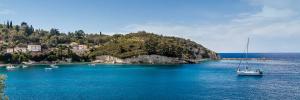
Ionian Islands
The Ionian Islands is the archipelago of western Greece that spans from the north to the mid-south of the country. It is comprised by six main islands, namely (from north to south) Corfu, Paxos, Lefkada, Ithaca, Kefalonia and Zakynthos. These and numerous smaller ones form an archipelagos of many islands of different sizes, each with a distinct character.
Although there are differences between the islands in terms of size, landscape and some other characteristics, in general the physical environment is similar in all and the climate does not vary considerably from the north to the south Ionian Sea. Western Greece is far rainier than the rest of the country and therefore all Ionian Islands are very green and rich in flora and fauna.
-
WHY ACT ON THE IONIAN ISLANDS?
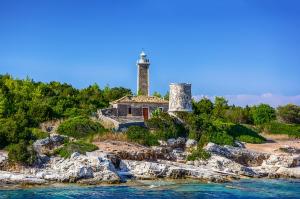
Summary of the current situation on the islands
Having fully scoped the environmental situation across the Ionian Islands, and analysed the urgency of certain issues, the following themes are our key areas of focus: waste management, marine conservation, landscape and biodiversity, and freshwater. For these we will be actively searching for projects to support, replicate and expand the reach of. Projects that fit more broadly within the environmental definition should also apply for funding and will be reviewed at our regular Steering Committee meetings.
Thanks to this beauty, the Ionian Islands are mainly known as holiday destinations. With the growth of tourism – Greece’s “heavy industry”- big changes came about. Local communities and institutions were largely unprepared for these changes. The land use regime, the waste management systems as well as water management have not been able to cope with the growing pressures, new conditions and demands. In a country that scores low in terms of imposing regulations and procedures, negative consequences are hard to control. Local crises and conflicts have emerged, particularly with illegal development and waste management (which is currently a real and increasingly serious problem in many of the islands).
At the same time the Ionian Sea faces many common threats: Garbage and plastic pollution, overfishing, reduction in populations of large marine mammals, such as dolphins and lately the great upcoming threat of oil prospecting in the whole Ionian.
On the positive side there are many passionate and knowledgeable people who have already made a difference with their work. There are some coastal and marine protected areas, however, the authorities often lack necessary means to make sure they operate effectively. The National Marine Park of Zakynthos, includes one of the most important sites of sea turtle reproduction in the Mediterranean. The endangered monk seals also seem to be increasing in numbers after sustained efforts by local conservationists.
While tourism has become key to the economic prosperity of most Ionian Islands, the most popular of these islands are now facing immediate and significant problems. Conversely, on islands like Ithaca, Lefkas and Kefalonia a more eco-friendly tourism industry is emerging. There is significant potential for a more sustainable tourism across the region. Alongside other factors, the “monoculture of tourism” has caused productive land to be abandoned and consequently a great dependence on food imports. Still many people choose to produce some of their own food and to buy local. Modern as well as traditional businesses with high quality food products, can be found on most of the islands, such as olive oil in Zakynthos, wine in Kephallonia, honey and kum-quat in Corfu, dairy in Kephallonia and Ithaka; mostly small in size. Turning to food production professionally comes with challenges; support can make a difference.
Freshwater supplies are greatly reduced due to overexploitation and contamination of aquifers, especially on Corfu. Inadequate clean (drinkable) water infrastructure results in islands needing to import huge quantities of bottled water. Such issues exacerbate the waste management problems. Biodiversity and resilient ecosystems are still rich, but under more and more pressure, and some species require active protection and regeneration.
-
Ionian history and culture
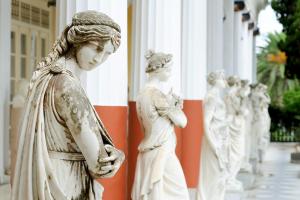
Historically, Ionian Islands were always on trade routes between the eastern and the western Mediterranean Sea and between the southern and the northern (European) Mediterranean cultures. This positioning has resulted in the Ionian Islands having a strategic importance during many periods of human history and have therefore been desired by close neighbours or conquerors from afar. It has also resulted in the islands having developed and maintained a common distinct culture that reaches the present time. Local people tend to be proud of this culture both because it is considered important traditional heritage and because it distinguishes them from other parts of Greece. The inhabitants of the Ionian Islands are known as very sociable, cheerful and vivid people with a good sense of humour and a great appetite for jokes.
Since the 1960s it has been the islands’ natural beauty that has gradually made the Ionian Islands famous and very popular as tourist destinations. But with the growth of the country’s “heavy industry” also problems came up which are by now impossible to ignore. This report will very briefly present the main environmental sustainability problems and threats that have been
identified along with their causes, as well as local groups and initiatives that have been active in the respective fields locally. -
Corfu
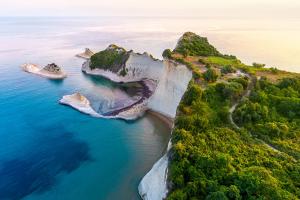
Corfu is the capital of the region of the Ionian Islands. Already in the ancient times – as described in Homer’s Odyssey- it was known as a wealthy and prosperous place that had achieved more than self-sufficiency. Due to the rich nature of the island, its climate and its fertile land a great variety of crops were produced in abundance, enabling Corfu’s inhabitants not only to enjoy, but also to export and trade the surplus produce of olive oil, wine, wheat and more. In terms of landscape Corfu is divided into three zones: the mountainous north, the middle that is hilly-semi mountainous, but includes expanses of flat lands -including the biggest valley of the island, Ropa valley- and the south with a considerably milder landscape. The island was always strategically important for the eastern Mediterranean and the trade routes between the Adriatic Sea, the Ionian Sea and mainland Greece. Therefore many empires controlled the island over the millennia and have left their marks on the island’s landscape.
Corfu is statistically the rainiest place of Greece and has a mild Mediterranean climate. With a permanent population of 102.071 and an expanse of 59.200 hectares Corfu is the third most densely populated prefecture/county of Greece (after Attica and Thessaloniki). Taking into account the tourism flows in the summer Corfu is one of the most densely populated islands of the Mediterranean Sea (already third most populated without tourism). The economy is dominated by tourism and the services sector, which together account for 91,4% of the local GDP, while primary production of goods only accounts for 2%.
-
Paxos
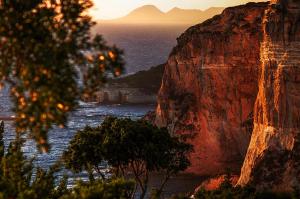
Paxos is located 7 miles south of Corfu. It is a single municipality comprised by a few islands and rocky islets. It has about 2.300 permanent inhabitants and more than 200.000 visitors per year. Most of the activity takes place in the three main coastal villages/areas. The whole island of Paxos is under the Natura 2.000 protection regime, which has been of great benefit. However, lack of monitoring and corruption essentially make this status largely ineffective.
Roughly, all of Paxos is “a big olive grove” (although not well taken care of and productive as in old times) and Antipaxos “a big vineyard”.
-
Lefkas (Lefkada)
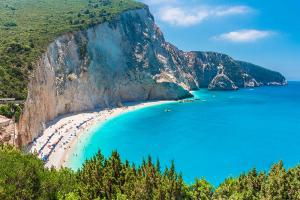
Lefkas has a size of 356 sq. kilometres and a population of 23.693 people. The municipality of Lefkada includes the islands of Kalamos and Kastos, while Meganisi forms a separate municipality. Lefkada is connected to ainland Greece by a strip of land with a bridge. Population is characterized as aging and the majority of it works in the tourism industry.
Lefkada is 60% mountainous and therefore big parts of it have not been affected by tourism or other intensive activities, preserving the natural beauty. The city of Lefkada, The area of Nydri (at an extreme) and some areas like Agios Nikitas are developed touristic destinations with some of the common consequences to a varying degree. The lagoon between Lefkas and Amvrakikos Bay (mainland) is an important biotope with rich biodiversity (marine, as well as birds), which is officially protected.
-
Kefalonia
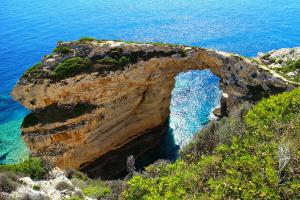
Kefalonia and Ithaki (Ithaca) together cover 786 square kilometres with a population of 39.032 and are closely linked. Of these 35.801 live in Kefalonia. Kefalonia is the biggest of all islands in size. Both islands face the problem of an aging population. The economy of the island used to be based on the agricultural sector with tourism being far less dominant than on the other main islands. There seems to be a gradual shift towards tourism services, albeit slow.
Kefalonia is mountainous and divided into vertically separated geographical departments. It is the richest of all islands in biodiversity, due to its geophysical characteristics and contains an interesting range of biotopes that include marshes and lakes between the mountain ranges. Ainos is the highest mountain and is protected as a national park. Within it there are millennia old forests of Kephalonian fir, wild/semi-wild horses, many bird species and a great wealth of biodiversity overall.
-
Ithaca (Ithaki)
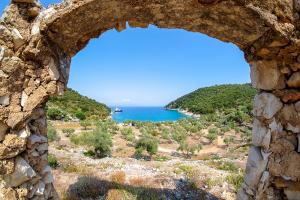
Approximately 3.231 people live in Ithaki, rendering the latter the second least populated after Paxos. Renowned as the home island of the mythical king Odysseus, Ithaki is probably the best preserved of all Ionian Islands, thereby preserving its natural beauty and charm. Ithaki has also maintained plenty of traditional greek crop varieties, agricultural practices for organic farming and animal races, which makes it invaluable for biodiversity preservation.
Next to the natural beauty Ithaca has a great variety of flora and fauna, some of which is special, such as the main variety of olive trees.
-
Zakynthos
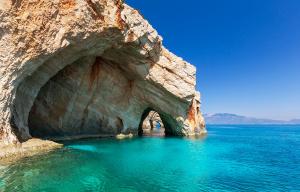
Zakynthos (or ‘Zante’ coming from italian) is the southernmost of the Ionian Islands. It is administered as a single municipality with the city of Zakynthos as the capital and only main city. With an extant of 405.600 acres it is the third in size and has 40.759 residents. Tourism is a dominant economic activity here as well with mass tourism from northern European countries being most common. However, Zakynthos has the most prosperous agricultural sector of all the Ionian Islands, which contributes significantly to the local economy.
Zakynthos” includes a wide variety of lowlands and mountain communities, as well as areas of exceptional natural beauty, with international visibility and great environmental and historical value and many monuments of traditional architectural heritage. The “Agricultural Zakynthos” occupies 95% of the total area of the island, where it houses about 70% of its total population. The existence of many statutory protected areas as Natura 2000 sites and the creation of the National Marine Park of Zakynthos prove the great value of the rich and –in some cases- rare flora and fauna of Zakynthos, which is a pole of attraction as well as a source of wealth for Zakynthos.
